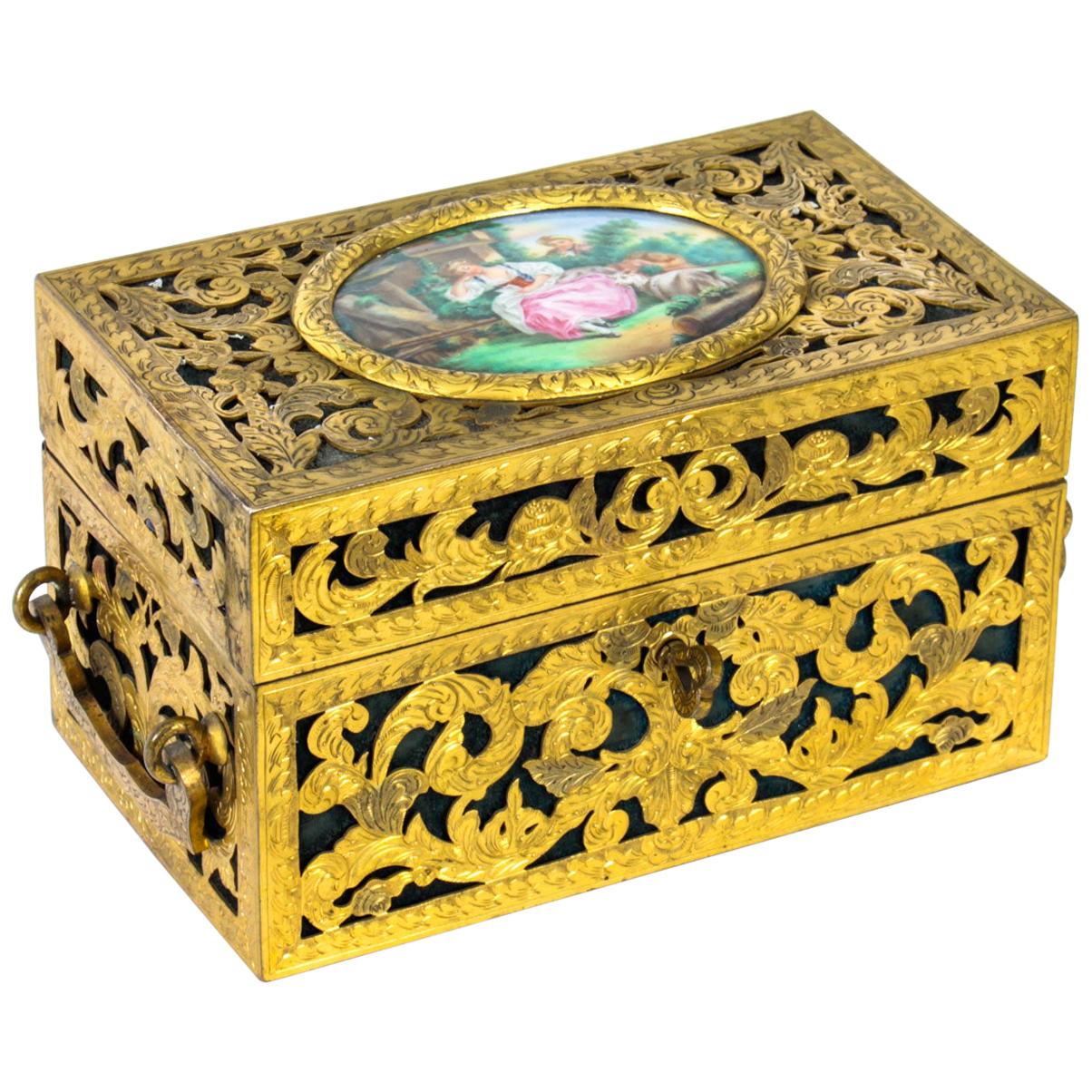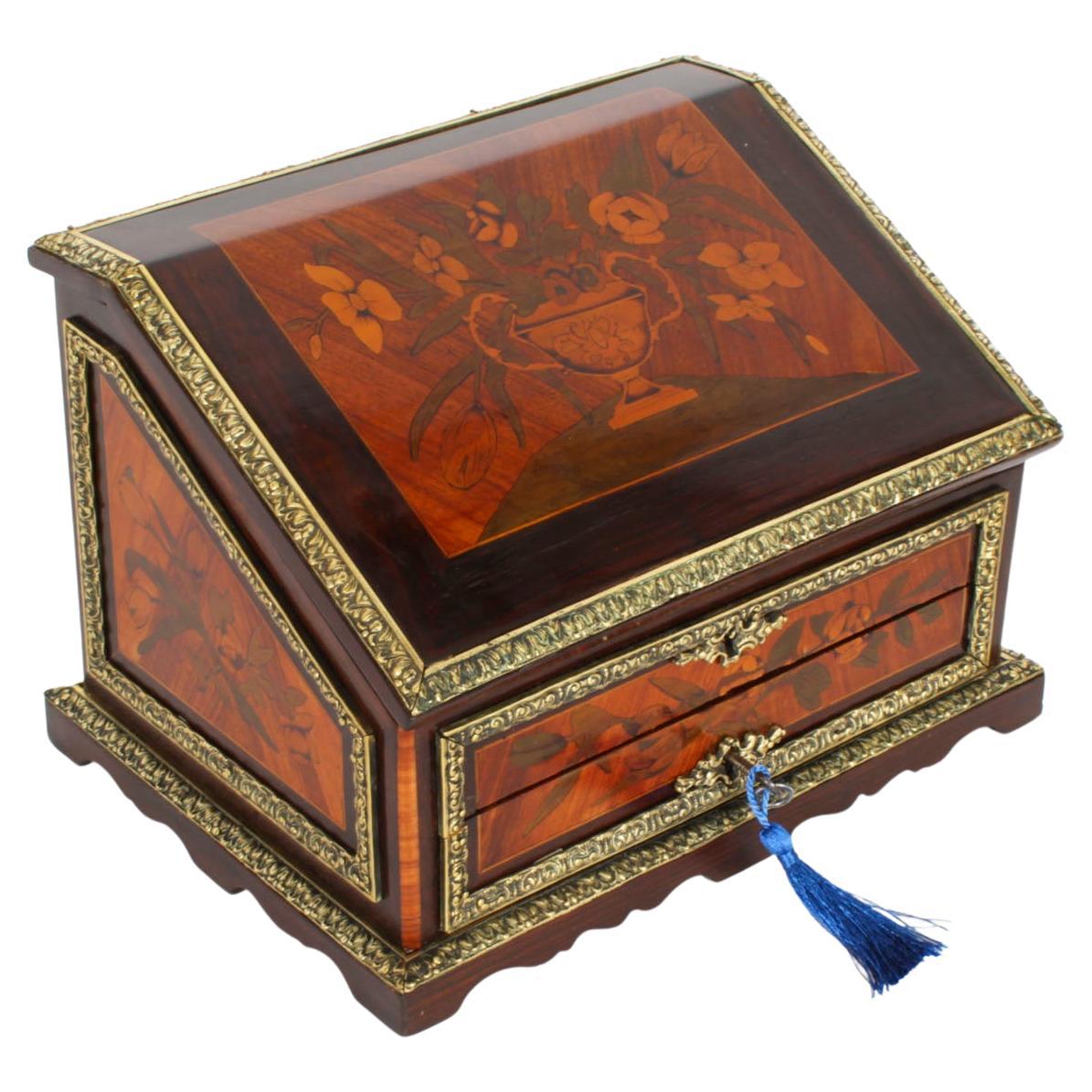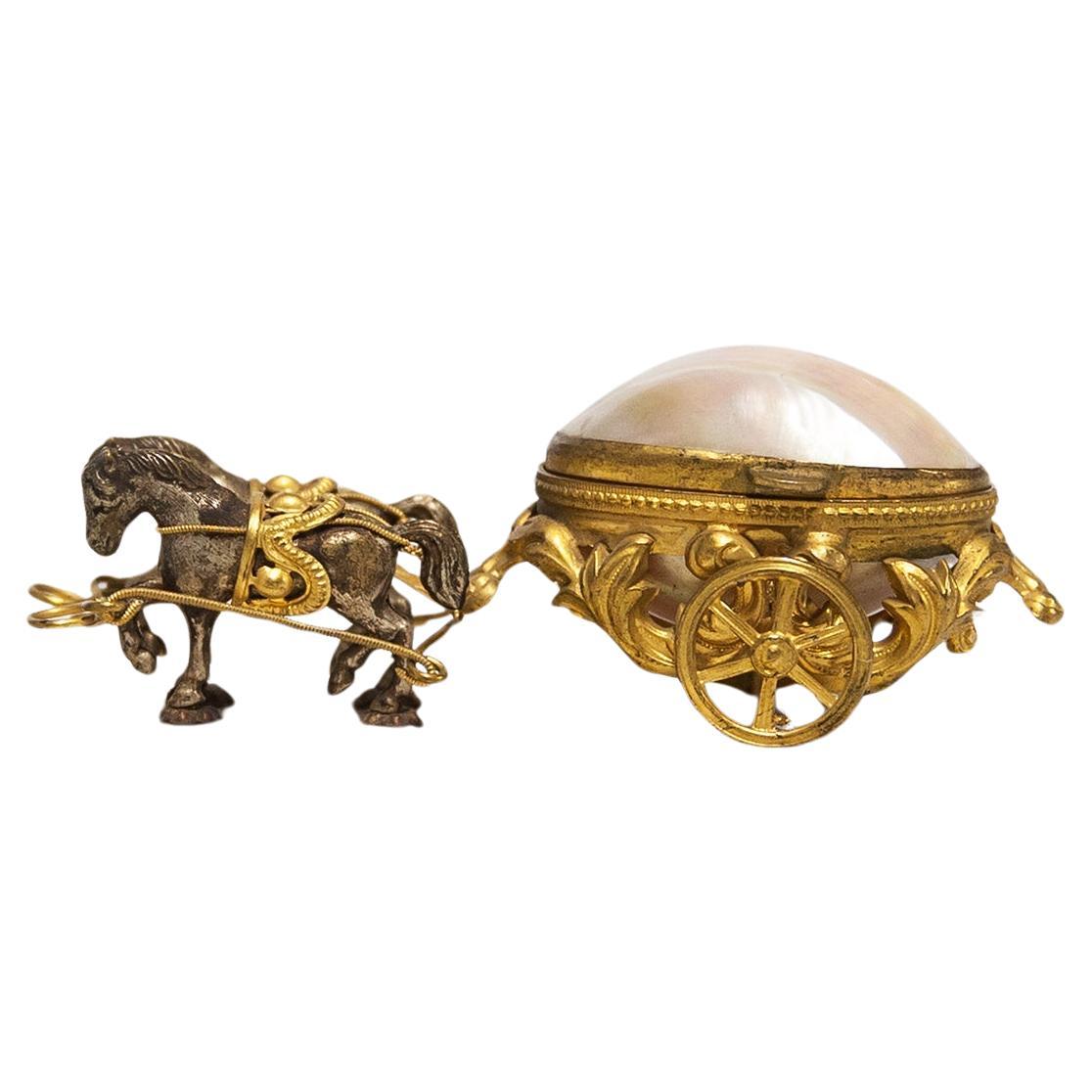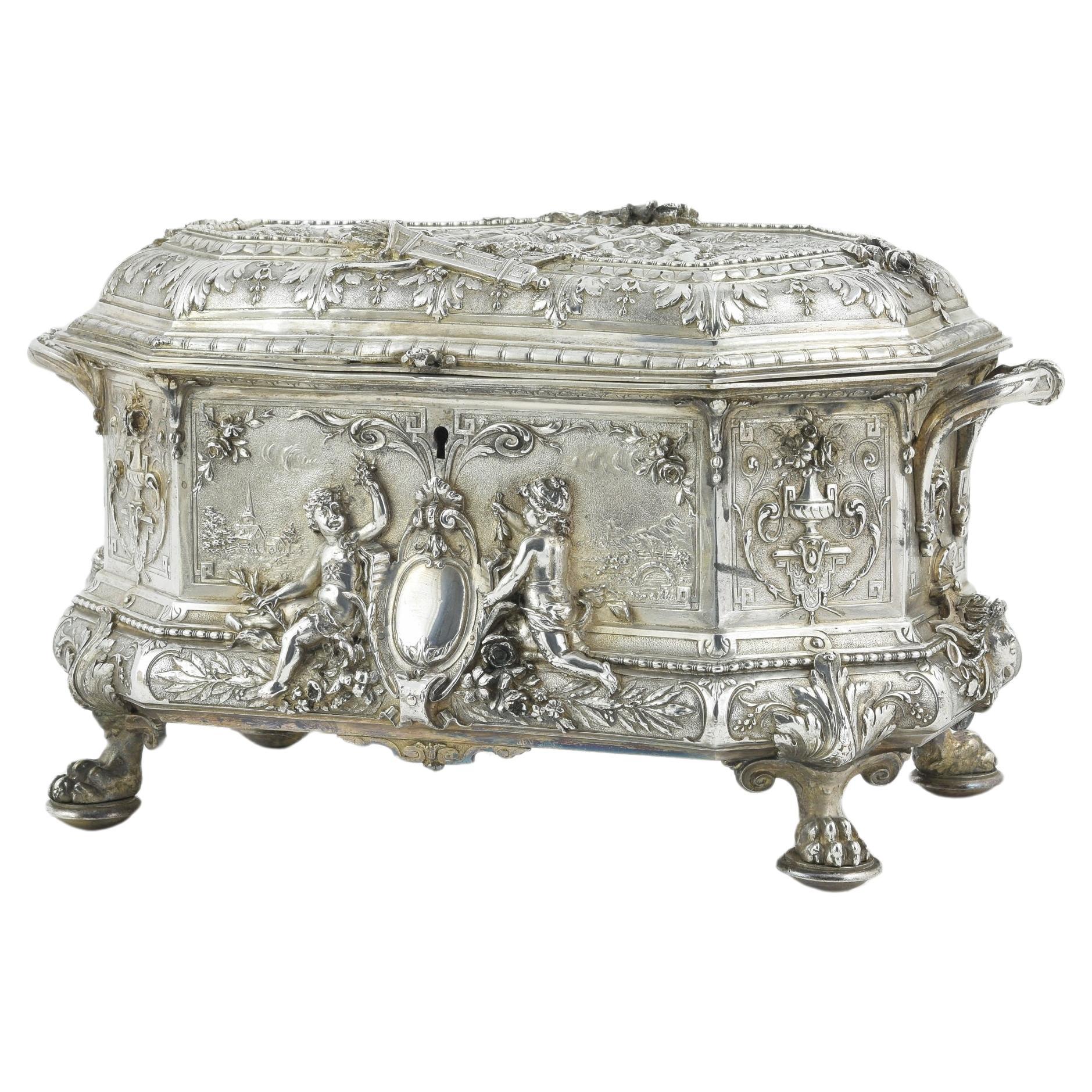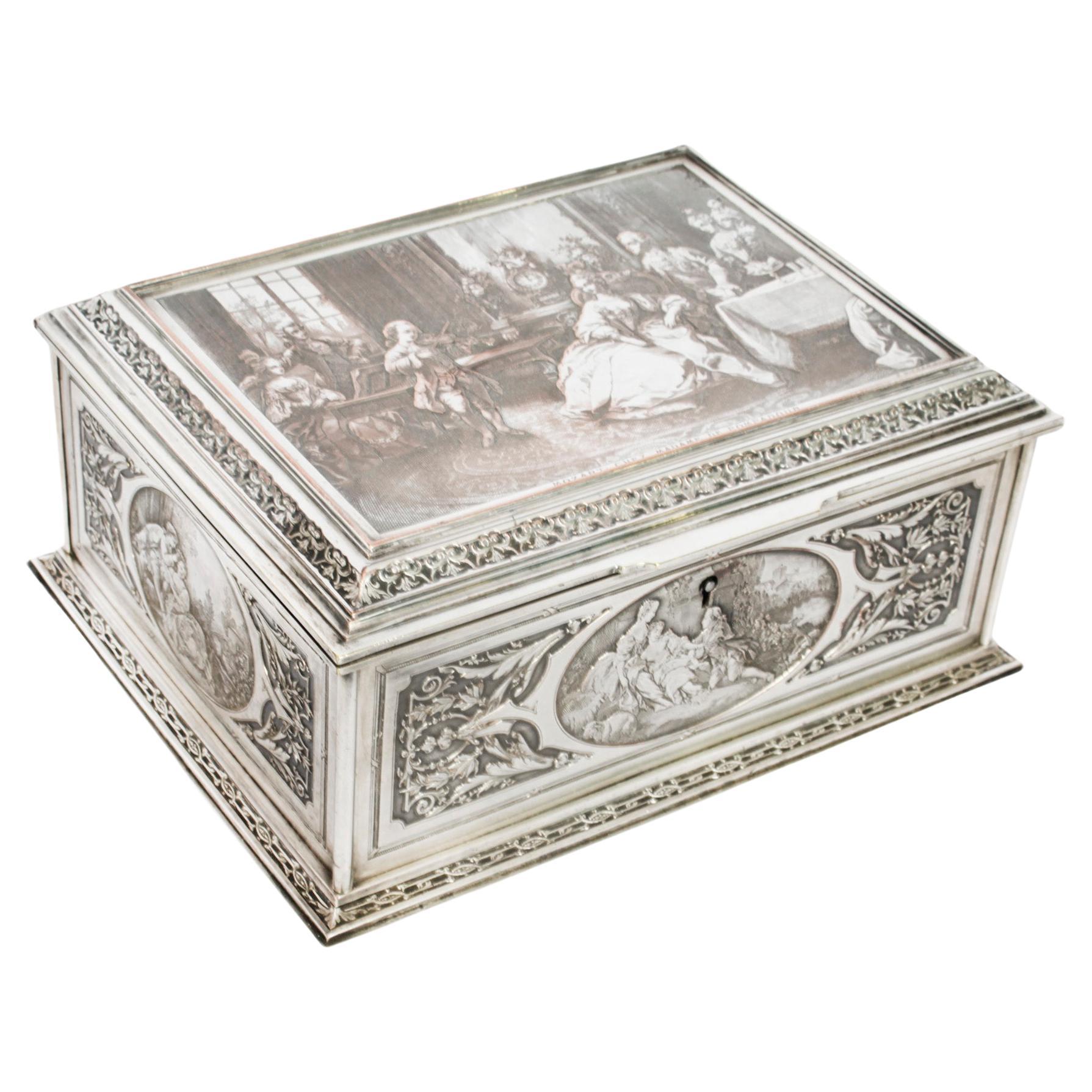Items Similar to Antique Palais Royal French Casket Necessaire Vanity Chest by L. Dujat 19th C
Video Loading
Want more images or videos?
Request additional images or videos from the seller
1 of 22
Antique Palais Royal French Casket Necessaire Vanity Chest by L. Dujat 19th C
About the Item
This is a fine and well fitted ebonised Gonçalo Alves Palais Royal travel necessaire / vanity chest, by Maison Smal L. Dujat - Palais Royal 7 (Paris), circa 1850 in date.
This superb vanity chest was made by L. Dujat, one of the artisans who had a workshop in the Paris street where the artisans of the Royal Palace worked, and his products were commissioned by the Court that resided in the now extinct Palais Royal.
The box features inlaid gilt banding and brass bound edges, the hinged cover opens to reveal a removable mirror, the interior with fitted silver plate mounted faceted glass jars, the lids engraved with foliate scroll decoration, the jars of square, circular, oval and rectangular form each sitting in shaped blue velvet recesses.
The front with brass fittings, the tops of the doors are inscribed with details of the retailer
'MAISON SMAL L. DUJAT Sr Bte SGDG PALAIS-ROYAL 7',
The number 7 is for the 7th arrondissement of Paris, which is today perhaps the most expensive area to live in Paris, the Eiffel Tower, one of the most famous tourist sites in the world, is located here, as well as many government buildings, ministries, the National Assembly and others. Many dignitaries and VIPs today prefer to live in this arrondissement.
The doors open to reveal three trays with beautiful brass inset handles that have superb engraved foliate decoration.
The top one with a fitted blue velvet tray with manicure and other tools, to include a file, penknife, scissors, button hook, corkscrew, pen, etc, . The middle tray with shaped storage boxes of varying form, one tin lined , the bottom one velvet lined for jewellery.
Complete with working lock and original key.
It is a lovely piece which apart from its functionality is also a decorative one.
Condition:
In really excellent condition. As an antique items, the chest show very minor signs of use commensurate with age, these minor condition issues are mentioned for accuracy and, as seen in the accompanying photographs, the chest displays beautifully.
Dimensions in cm:
Height 20 x Width 35 x Depth 27
Dimensions in inches:
Height 8 inches x Width 1 foot, 2 inches x Depth 11 inches
Palais Royale
In the mid 1800s the best souvenirs from Paris were found in the boutiques of the famed Palais Royal of Paris, which is the old palace of Cardinal Richelieu. The boutiques lined the promenade of the central gardens, and the area was host to Royals, dignitaries, the posh societies of times past. The treasures from the Palais Royal remain today some of the most sought after antiques to be found.
Gonçalo Alves is a hardwood (from the Portuguese name, Gonçalo Alves). It is sometimes referred to as tigerwood — a name that underscore the wood’s often dramatic, contrasting color scheme.
While the sapwood is very light in color, the heartwood is a sombre brown, with dark streaks that give it a unique look. The wood’s color deepens with exposure and age and even the plainer-looking wood has a natural luster.
Two species are usually listed as sources for gonçalo alves: Astronium fraxinifolium and Astronium graveolens, although other species in the genus may yield similar wood; the amount of striping that is present may vary.
In the high tropical forests of Central and South America, well-drained soils furnish nutrients for a variety of dense, durable hardwoods sought for maritime use, heavyconstruction, and furniture. The Spanish began harvesting in Latin American forests in the early 1500s to provide timber for boatbuilding and repair. By the early 1900s, however, steel ships had replaced wooden ones, and the interest in tropical forests by both Europeans and Americans shifted to appearance-grade woods for furniture.
Although history fails to provide us with a shopping list of species from either harvest period, it's probable that the wood we know today as goncalo alves has always been sought. That's because goncalo alves, considered one of the most beautiful of tropical woods, has a tough reputation, too. Strong and durable, it's used for construction in its homeland and secondarily for fine furniture. Woodworkers elsewhere treasure the wood for decorative items and veneer accents.
- Dimensions:Height: 7.88 in (20 cm)Width: 13.78 in (35 cm)Depth: 10.63 in (27 cm)
- Materials and Techniques:
- Place of Origin:
- Period:
- Date of Manufacture:circa 1850
- Condition:
- Seller Location:London, GB
- Reference Number:
About the Seller
5.0
Platinum Seller
These expertly vetted sellers are 1stDibs' most experienced sellers and are rated highest by our customers.
Established in 1983
1stDibs seller since 2012
1,199 sales on 1stDibs
Typical response time: <1 hour
Associations
LAPADA - The Association of Arts & Antiques Dealers
- ShippingRetrieving quote...Ships From: London, United Kingdom
- Return PolicyA return for this item may be initiated within 14 days of delivery.
More From This SellerView All
- Antique Pierced Brass Palais Royal Porcelain Mounted Casket, 19th CLocated in London, GBThis is a stunning antique 19th century French Palais Royal pierced brass and porcelain mounted domed rectangular table casket , Circa 1870 in date...Category
Antique 1870s French Decorative Boxes
MaterialsBrass
- Antique French Marquetry and Ormolu Stationary Casket . 19th CenturyLocated in London, GBThis is a wonderful antique French Gonçalo Alves marquetry and ormolu mounted casket, circa 1860 in date. The casket of bureau form has a lift up top and is inlaid with a marquetry ...Category
Antique 1860s Decorative Boxes
MaterialsOrmolu
- Antique Huge French Amboyna Porcelain Cameo Writing Casket 19th CLocated in London, GBA French ormolu and porcelain cameo mounted amboyna writing box, circa 1860 in date. The rectangular casket features a lid with a central floral hand painted porcelain panel, cross...Category
Antique 1860s Decorative Boxes
MaterialsOrmolu
- Antique French Silvered Copper Jewellery Casket Box B Wicker 19th CLocated in London, GBThis is a beautiful Antique silvered copper French Jewellery Casket, engraved by by the famous French engraver B.Wicker, Paris C 1880's. This...Category
Antique 1880s French Jewelry Boxes
MaterialsCopper
- Antique French Silvered & Gilt Jewellery Casket Box AB Paris 19th CLocated in London, GBThis is a beautiful Antique silvered and gilt on copper French jewellery casket, signed AB Paris and Circa 1880 in date. Of rectangular form this wonderful casket is of very high quality and features the lid and sides decorated with relief cast scenic panels...Category
Antique 1880s French Jewelry Boxes
MaterialsCopper
- Antique Ormolu & Agate Mounted Casket by Asprey, 19th CenturyLocated in London, GBThis is a superb antique gilt bronze and agate mounted casket by Asprey, Circa 1870 in date. The casket features a rectangular outline with domed lid which opens to reveal two clear glass scent bottles. It is stamped Charles Asprey, 166 Bond Street, Provenance: Lady Elizabeth Prinfle Lady in waiting to Queen Victoria, lived at Bonchurch, Isle of Wight It is a lovely piece which will make an unforgettable gift. Condition: In excellent condition having been beautifully cleaned in our workshops, please see photos for confirmation. Dimensions in cm: height 10.5 x width 12.5 x depth 7.5 Dimensions in inches: height 4 inches x width 5 inches x depth 3 inches Asprey was established in England in 1781 and founded as a silk printing business by William Asprey, it soon became a luxury emporium. In 1841, William Asprey's elder son Charles went into partnership with a stationer located on London's Bond Street. In 1847 the family broke with this partner and moved into 167 New Bond Street, the premises Asprey occupies today. From its central London location Asprey advertised 'articles of exclusive design and high quality, whether for personal adornment or personal accompaniment and to endow with richness and beauty the table and homes of people of refinement and discernment.' An early speciality was dressing cases. Asprey crafted traditional cases and designs, mostly in leather, suitable for the new style of travel ushered in by railways. The main competitors at the time were H.J. Cave & Sons. Asprey was recognised for its expertise when it won a gold medal for its dressing cases at the International Exhibition of 1862 but lost out to its rivals, H.J. Cave & Sons in 1867. The company consolidated its position through acquisitions. In 1859 Asprey absorbed Edwards, an award winning maker of dressing cases and holder of a Royal Warrant. The company also purchased the Alfred Club at 22 Albemarle Street, which backed on to the New Bond Street store and meant that Asprey now had entrances on two of London's most fashionable streets. In 1862, Asprey was granted a Royal Warrant by Queen Victoria. The Prince of Wales, later to be crowned Edward VII, granted another Royal Warrant. In 1953, for the coronation of Elizabeth II, Asprey paid homage with the Asprey Coronation Year Gold Collection, which featured a dessert, coffee and liqueur service in 18-carat gold and weighed almost 27 pounds. In April 1953, it went on show in the New Bond Street store and subsequently toured the United States. As the business grew, the company acquired manufacturing facilities and hired silversmiths, goldsmiths, jewellers and watchmakers including Ernest Betjeman, the father of the distinguished poet John Betjeman, one of the most highly regarded craftsman and designers of his day. In the twenties, commissions poured in from around the world, from American millionaire J. Pierpont Morgan to potentates such as the Maharaja of Patiala, who commissioned a huge teak travelling trunk for each of his wives in which each trunk was fitted with solid silver washing and bathing utensils with waterspouts of ornate tiger head and lined with blue velvet. Asprey cigarette cases became collectable amongst young sophisticates who delighted in its other modern products, including travel clocks, safety razors and automatic pencil sharpeners. Asprey Jewellery Asprey has a tradition of producing jewellery inspired by the blooms found in English gardens. Over the decades jewelled interpretations of flowers have evolved to include the Crown Daisy, Rose, Calla Lily and Lily Pad collections. The master diamond cutter Gabi Tolkowsky created the Asprey cut. The cushion cut gave Tolkowsky options for incorporating the Asprey "A" inscription around the edges of the stone. The result was the 61-facet Asprey cut, maximising light refraction to brilliant effect. The shape of the Asprey cut means that the cutting process can be done only by hand, unlike many other stones that involve machine cutting. Asprey Leather - the women's collection of clutches and handbags, such as those featured in the 1781 collection, come from crocodile, python and ostrich. The men's collection includes wallets, cardholders and travel watch cases crafted from lido, calf or alligator. Other items include the briefcases and backgammon boards. Asprey Silver - offers classic and whimsical contemporary silver pieces – such as the saltcellar fashioned to look like a cement mixer...Category
Antique 1870s English Decorative Boxes
MaterialsAgate, Ormolu
You May Also Like
- Palais Royal Horse-Drawn Carriage Trinket Box 19th CenturyLocated in Munich, DEA ‘Palais Royal’ miniature horse-drawn carriage trinket box made with mother of pearl, silver-plated horses and gold plated metal. 19th century.Category
Antique Late 19th Century French Rococo Jewelry Boxes
MaterialsMarble, Gold Plate, Silver Plate
- French 19th Century Silver Plated CasketLocated in London, GBThe whole casket is richly decorated. Standing on lions paw feet adorned with baroque motifs the scene on top depicts cupid stood beside two lovers (possibly) Daphne and Apollo. The ...Category
Antique 19th Century French Jewelry Boxes
MaterialsSilver Plate
- 19th Century Antique Oak Briefnbox/Casket, GermanyLocated in Berlin, DE19th Century Antique Oak Briefnbox/Casket, Germany Rectangular solid oak body with fittings. The box is relatively large and wide and offers a lot of space. The box can be used in m...Category
Antique 19th Century German Decorative Boxes
MaterialsIron
- 19th Century Sevres CasketBy Manufacture Nationale de SèvresLocated in London, GBA rare antique French gilt bronze and silver Sevres porcelain casket finely painted with neoclassical figures on two round and two rectangular ...Category
Antique Late 19th Century French Decorative Boxes
MaterialsCeramic
- 19th Century Oakwood CasketLocated in Vienna, ATAn attractive small oakwood casket most probably manufactured in the late 19th century. This object, richly decorated with external metal fittings has three drawers inside and quotes...Category
Antique 1890s Italian Renaissance Revival Vitrines
MaterialsMetal
- Antique 19th Century Malachite and Ormolu CasketLocated in London, GBAntique 19th century malachite and ormolu casket Russian, Mid-19th Century Height 9cm, width 21cm, depth 15cm This magnificent malachite casket celebrates the work of 19th century ...Category
Antique Mid-19th Century Russian Decorative Boxes
MaterialsMalachite, Ormolu
Recently Viewed
View AllMore Ways To Browse
L Object
Royal France
Antique French L
L Jewelry Box
Antique Royal Color
Locking Silver Box
Lock Box Silver
Antique Furniture Sites
Decorative Hook
Spanish French Antiques
Tooled Jewelry Box
Natural History Objects
Royal French Antique Furniture
Early American Box
Silver French Jewelry Box
Silver And Glass Box Antique Box
Grade L
Antique Objects List
